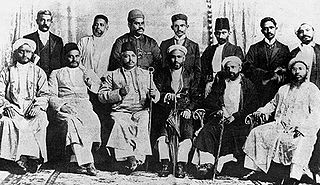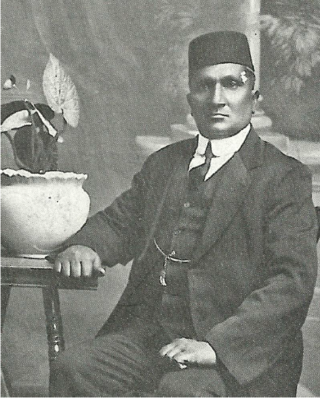
Fatima Meer was a South African writer, academic, screenwriter, and prominent anti-apartheid activist.
The following lists events that happened during 1946 in South Africa.

Group Areas Act was the title of three acts of the Parliament of South Africa enacted under the apartheid government of South Africa. The acts assigned racial groups to different residential and business sections in urban areas in a system of urban apartheid. An effect of the law was to exclude people of colour from living in the most developed areas, which were restricted to Whites. It required many people of colour to commute large distances from their homes to be able to work. The law led to people of colour being forcibly removed for living in the "wrong" areas. People of colour, who were the majority at the time, were given much smaller areas to live in than the white minority. Pass Laws required people of colour to carry pass books and later "reference books", similar to passports, to enter the "white" parts of the country.

The Natal Indian Congress (NIC) was a political organisation established in 1894 to fight discrimination against Indians in the Natal Colony, and later the Natal Province, of South Africa. Founded by Mahatma Gandhi, it later served an important role in opposing apartheid. It was the oldest affiliate of the South African Indian Congress.
Gangathura Mohambry "Monty" Naicker was a South African anti-apartheid activist. He is best known for his tenure as president of the Natal Indian Congress (NIC) between 1945 and 1963. He also served as president of the South African Indian Congress.
Chatsworth is a large township in KwaZulu-Natal, South Africa established in the 1950s to segregate the Indian population and create a buffer between the white suburbs of Durban to the north and the black townships of Durban to the south. Located in the Southern Durban basin and roughly bordered by the Umhlatuzana River in the North and Umlaas River in the South, the suburb is made up mainly of Indian/Asian and Black African people.

Govindasamy Krishnasamy Thambi Naidoo was a South African civil rights activist. He was an early collaborator of Mahatma Gandhi leading many protests in then South Africa against racial discrimination targeted at the Indian community.

The Natives Land Act, 1913 was an Act of the Parliament of South Africa that was aimed at regulating the acquisition of land. It largely prohibited the sale of land from whites to blacks and vice-versa.
The National Union of South African Students (NUSAS) was an important force for liberalism and later radicalism in South African student anti-apartheid politics. Its mottos included non-racialism and non-sexism.

The system of racial segregation and oppression in South Africa known as apartheid was implemented and enforced by many acts and other laws. This legislation served to institutionalize racial discrimination and the dominance by white people over people of other races. While the bulk of this legislation was enacted after the election of the National Party government in 1948, it was preceded by discriminatory legislation enacted under earlier British and Afrikaner governments. Apartheid is distinguished from segregation in other countries by the systematic way in which it was formalized in law.
The South African Indian Congress (SAIC) was an umbrella body founded in 1921 to coordinate between political organisations representing Indians in the various provinces of South Africa. Its members were the Natal Indian Congress (NIC), the Transvaal Indian Congress (TIC), and, initially, the Cape British Indian Council. It advocated non-violent resistance to discriminatory laws and in its formative years was strongly influenced by the NIC's founder, Mahatma Gandhi.

Indian South Africans are South Africans who descend from indentured labourers and free migrants who arrived from British India during the late 1800s and early 1900s. The majority live in and around the city of Durban, making it one of the largest ethnically Indian-populated cities outside of India.

The Representation of Natives Act No 12 of 1936 was legislation passed in South Africa which further reduced black rights at the time. The Cape province had a qualified franchise which had allowed a small number of blacks in the Cape to vote for the common roll in terms of the Cape Qualified Franchise. The qualified franchise dated back to the pre-Union period, when the Cape was a separate British colony; it also excluded poorer white men. The 1936 Act removed blacks to a separate roll – and halted the right to run for office; other earlier legislation removed the qualifications imposed in the Cape on whites.

In 1953, the Public Safety Act was enacted by the apartheid South African government. This Act empowered the government to declare stringent states of emergency and increased penalties for protesting against or supporting the repeal of a law.

Kesaveloo Goonam, also known as Kesaveloo Goonaruthnum Naidoo (1906–1998) was a South African doctor and anti-apartheid activist. She was also called "Coolie Doctor", which became the title of her 1991 autobiography.
The Beer Hall Boycott of South Africa was a nationwide, women-led campaign of boycotting and demonstrating against municipal beer halls stretching from roughly the 1920s to the 1960s. The Native Beer Act of 1908 had made it illegal for South African women to brew traditional beer. Police raided homes and destroyed home-brewed liquor so that men would use municipal beerhalls. In response, women attacked the beerhalls and destroyed equipment and buildings.
The Mayibuye Uprising was a sequence of protests and demonstrations, led by the African National Congress, South African Indian Congress and the African People's Organisation that took place around No.2 Location Galeshewe, in Kimberley, on 7–8 November 1952. The uprising was not an isolated event, but part of the Defiance Campaign which started in June 1952. The aim of the campaign was to peacefully defy the laws of the apartheid government across the country.
Dr. Zainab Asvat was a South African anti-apartheid activist. Asvat was trained as a medical doctor, but was politically active most of her life.
Solidarity was a political party created in the lead-up to the 1984 South African general election, which determined the makeup of the first House of Delegates, the body within the Apartheid Tricameral Parliament reserved for Indian South Africans. It took its name from the Polish trade union.p. 40 Its first leader was JN Reddy, an influential banker and businessman with a number of company directorships. To be able to lead the party, Reddy relinquished some of his business interests. Another important party member was Pat Poovalingam, the chairman of weekly newspaper "The Graphic". Solidarity appealed more to South Africans with Southern Indian roots, while Amichand Rajbansi's National People's Party appealed more to those with a North Indian heritage.
Kesval Moonsamy was a South African trade unionist, politician and anti-apartheid activist. He was one of the 156 accused in the 1956 Treason Trial. He went into exile in 1965 and returned to South Africa in 1991. Moonsamy was elected treasurer of the South African Communist Party in 1997 and served as an African National Congress Member of Parliament from 1999 until 2009.









